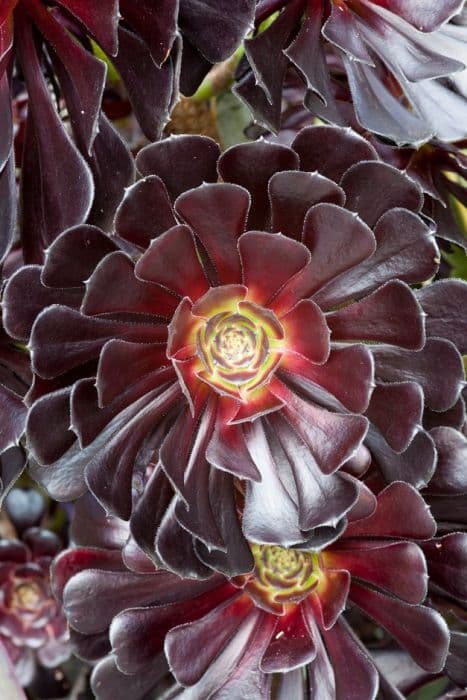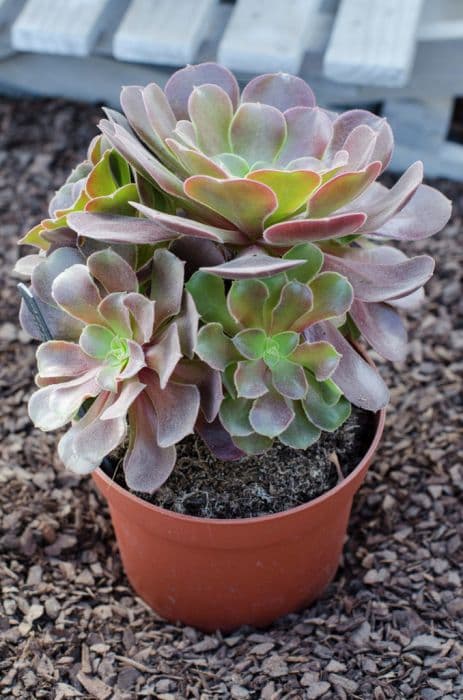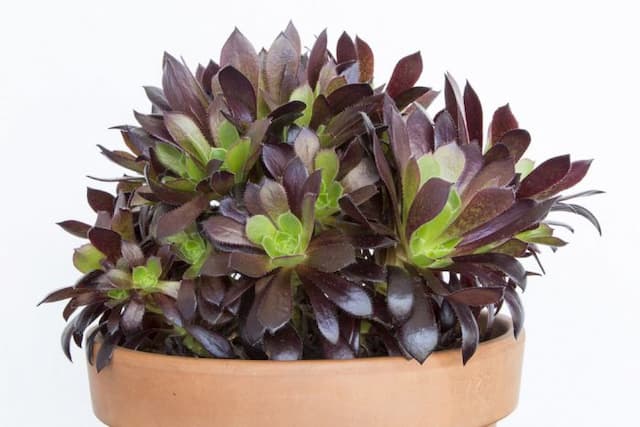Hen and Chicks Sempervivum 'Commander Hay'

ABOUT
Sempervivum 'Commander Hay', commonly known as Hen and Chicks, is a perennial succulent plant with a distinctive and attractive appearance. The plant is characterized by its rosettes of thick, fleshy leaves that are often tipped with a contrasting color. Each rosette is symmetrical, creating a visually pleasing geometric pattern with the leaves emanating from a central point. The leaves of the Hen and Chicks are typically green, but depending on the variety and environmental conditions, they can take on shades of red, purple, or bronze, especially towards the tips. The leaves have a slightly pointed shape and sometimes exhibit fine cilia or hair-like features along the edges, which can add to their unique texture. The Sempervivum 'Commander Hay' is also noted for its resilience and ability to thrive in a wide range of conditions. During the flowering period, it produces tall flower stalks that rise above the rosette, bearing star-shaped flowers. These blooms are usually pink, red, or sometimes yellow, adding an eye-catching aspect to the plant when in bloom. Overall, Hen and Chicks is a compact, low-growing plant that forms dense mats of rosettes over time, creating a carpet of succulent foliage. Its appealing color variations and ease of care make it a popular choice for rock gardens, containers, and green roofs, as well as a favorite among succulent collectors and garden enthusiasts.
About this plant
 Names
NamesFamily
Crassulaceae.
Synonyms
Hen And Chicks, Houseleek, Liveforever.
Common names
Sempervivum 'Commander Hay'
 Toxicity
ToxicityTo humans
The Sempervivum 'Commander Hay', commonly known as Houseleek, is not considered toxic to humans. Generally, it can be safely handled and is not known to cause adverse reactions upon contact or ingestion. However, as with any plant, individual allergies or reactions are possible. If a person ingests Houseleek and experiences any unusual symptoms, they should consult with a healthcare provider.
To pets
Houseleek, the common name for Sempervivum 'Commander Hay', is also considered non-toxic to pets. It does not typically pose a threat if pets come into contact with it or ingest it. However, ingestion of any plant material may cause mild gastrointestinal upset in some pets. If a pet consumes Houseleek and exhibits symptoms such as vomiting or diarrhea, it is advisable to consult a veterinarian.
 Characteristics
CharacteristicsLife cycle
Perennials
Foliage type
Evergreen
Color of leaves
Green
Flower color
Pink
Height
0.5 feet (15 cm)
Spread
1 foot (30 cm)
Plant type
Succulent
Hardiness zones
5
Native area
Europe
Benefits
 General Benefits
General Benefits- Easy to grow – Commander Hay is a low-maintenance plant, requiring minimal care.
- Drought-tolerant – Once established, it can survive with very little water.
- Cold-hardy – It can endure cold temperatures, making it suitable for various climates.
- Suitable for container gardening – Its compact size makes it ideal for pots and planters.
- Attracts pollinators – Its flowers can attract bees and other beneficial insects.
- Visual appeal – Offers aesthetic value with its rosette shape and colorful leaves.
- Propagation ease – Easily propagates from offsets, providing more plants over time.
- Ground cover – Can spread to form a dense mat, helping to suppress weeds.
- Rooftop and vertical gardens – Due to its shallow root system, it's suitable for green roofs and vertical gardens.
 Medical Properties
Medical PropertiesThis plant is not used for medical purposes.
 Air-purifying Qualities
Air-purifying QualitiesThis plant is not specifically known for air purifying qualities.
 Other Uses
Other Uses- Roof Planting: Sempervivum 'Commander Hay' is often used in green roofs for its hardiness, drought resistance, and its ability to thrive in shallow soil.
- Lucky Charm: In some cultures, these plants are considered to bring good luck and are often gifted to friends or family when moving into a new home.
- Education and Research: The plant can be used by botany and horticulture students for studying survival strategies in succulents, as it exemplifies exceptional drought resistance.
- Artistic Inspiration: Artists may use the geometric patterns and symmetry of the rosettes as inspiration for designs, paintings, and sculptures.
- Photography: Due to their unique beauty, 'Commander Hay' succulents can be a subject for professional and amateur photographers, particularly macro photography enthusiasts.
- Thermal Insulation: Being an excellent ground cover, they can help with reducing heat loss when planted extensively on the ground around a building.
- Culinary Decoration: While not commonly eaten, they can be used as non-toxic, decorative elements on plates in high-end gastronomy.
- Drought-Tolerant Landscaping: Gardeners may use this plant in xeriscaping, a landscaping method that reduces or eliminates the need for irrigation.
- Feng Shui: These plants can be used to add elements of greenery and earthiness in Feng Shui applications, symbolizing balance and harmony.
- Garden Borders: Their compact size makes them suitable for creating defined edges along pathways or garden beds, adding structure to the landscape design.
Interesting Facts
 Feng Shui
Feng ShuiThe Hen and Chicks is not used in Feng Shui practice.
 Zodiac Sign Compitability
Zodiac Sign CompitabilityThe Hen and Chicks is not used in astrology practice.
 Plant Symbolism
Plant Symbolism- Resilience: The Sempervivum 'Commander Hay', commonly known as Hen and chicks, is able to thrive in harsh conditions, symbolizing one's ability to endure and recover from adversity.
- Protection: This plant has a rosette shape that resembles an armor, representing defense and safety in one's home or life.
- Perseverance: Hen and chicks can grow in rocky and poor soil, symbolizing persistence and the tenacity to persist even in challenging environments.
- Longevity: The name Sempervivum itself means 'always alive' or 'ever-living', signifying longevity and eternal life in symbolism due to its hardy nature.
 Water
WaterHens and chicks, the common name for Sempervivum 'Commander Hay', should be watered thoroughly, allowing the water to soak in and then letting the soil dry out completely between waterings. Typically, this means that you could water your plant every 7-10 days during the active growing season, depending on climate conditions, but less frequently during the cooler, dormant period. It's crucial to avoid overwatering, which can lead to root rot. When you do water, aim to provide approximately 1 gallon of water for outdoor plants in garden beds every 7-10 days, adjusting as necessary for potted plants based on pot size.
 Light
LightHens and chicks thrive best in bright light conditions and should be placed in a spot where they receive full sun to partial shade. They do well with around 6 hours of direct sunlight daily, so a south-facing window or an unobstructed outdoor location is ideal for indoor and outdoor plants, respectively. Ensure that they are not shaded by taller plants or structures to maintain their health and coloration.
 Temperature
TemperatureHens and chicks can endure a wide range of temperatures and are very cold hardy. They can survive in temperatures as low as -20°F to -30°F and can handle high temperatures well into the 80s°F, making them excellent for various climates. The ideal temperature range for Sempervivum 'Commander Hay' is between 65°F and 75°F during the growing season, but they can tolerate fluctuations beyond these limits without significant harm.
 Pruning
PruningPruning is mostly unnecessary for Hens and chicks but removing dead or damaged leaves can help maintain the plant's appearance. The best time for any pruning is the growing season, spring through early fall. You may also want to trim back the flower stalks after the blooms have faded to encourage more rosette growth. Generally, Hens and chicks are low-maintenance in this regard, needing attention only occasionally.
 Cleaning
CleaningAs needed
 Soil
SoilThe Hen and Chicks plant (Sempervivum 'Commander Hay') thrives in well-draining soil with a gritty mix like 50% potting soil and 50% perlite or coarse sand. It prefers a slightly acidic to neutral pH, ranging from 6.0 to 7.5.
 Repotting
RepottingHen and Chicks should be repotted every 2-3 years to refresh the soil and accommodate growth. Spring or early summer is the best time for repotting.
 Humidity & Misting
Humidity & MistingHen and Chicks prefer a dry, low humidity environment, similar to their native alpine habitats. They can tolerate a wide range of humidity levels but prefer dry air.
 Suitable locations
Suitable locationsIndoor
Place Hen and Chicks in bright light, avoid overwatering, well-draining soil.
Outdoor
Full sun to partial shade, well-draining soil, drought-tolerant.
Hardiness zone
3-8 USDA
 Life cycle
Life cycleThe life cycle of Sempervivum 'Commander Hay', commonly known as Hens and Chicks, begins with germination from seed or vegetative propagation through offsets, which are small rosettes that form around the base of the parent plant. As these rosettes mature, they develop their characteristic thick, fleshy leaves that store water, adapting them to harsh, sunny environments. The plant grows at a moderate rate, forming clusters of rosettes that spread outwards as offsets continue to grow. After several years, the original rosette, now the "hen," will produce a flower stalk, marking the onset of the reproductive stage. The flowers are usually pink or red, and after pollination, they set seed, which then spreads to give rise to new plants. Finally, having completed its reproductive cycle, the flowering rosette dies, leaving behind the offsets or "chicks" to continue the growth cycle.
 Propogation
PropogationPropogation time
Spring-Early Summer
The Sempervivum 'Commander Hay', commonly known as Hen and Chicks, is best propagated through division, a process which can be done in spring or early summer. This involves gently separating the offsets, which are the small rosettes that form at the base of the parent plant. These offsets are often connected by a stolon, or a root-like structure, and can simply be twisted off or cut with a clean, sharp knife. Once removed, the offsets can be left to dry for a day or two to allow the cut end to callous over, which helps to prevent rot. They are then planted in well-draining soil, placed in a bright area with indirect light, and watered sparingly until they establish roots. After a few weeks, the offsets should begin growing into new, independent plants.









